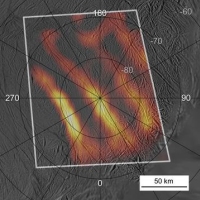Composition and Origin of Enceladus' Plume
27 March 2008
During Cassini's close flyby of Enceladus on 12 March, the spacecraft flew through the moon's plume that originates from jets in Enceladus' south polar region. Both the plume and the south polar surface were studied during this very close approach of Saturn's sixth largest moon.The Ion and Neutral Mass Spectrometer (INMS) analyzed the chemical composition of the plume as Cassini flew through its outskirts at altitudes upward of ~190 km. From the observed mass spectrum, water vapour, CH4, CO, CO2, simple organics and complex organics have been identified. Very surprisingly, the relative abundances fall in the range of abundances observed from comets. Why the plume material should match this pristine composition from the early times of the Solar System is a challenging question for models explaining the formation of the Saturn system.
 |
|
CIRS temperature map based on 12-16 μm emission overlaid on image of Enceladus' south pole. |
The map shows that the south-polar fractures are active along almost their full lengths with the level of activity varying greatly along them. Remarkably high temperatures of at least 180 K were registered along the brightest fracture - in contrast with surface temperatures elsewhere in the south-polar region of below 72 K.
The warmest parts of the fractures tend to lie on locations of the plume jets. In addition, some warm spots offset from the fractures were found. The new data will help to better understand what processes power the geysers responsible for Enceladus' plume.
For more details of Cassini's findings at Enceladus during the recent flyby see the news release at the ESA Science Portal
